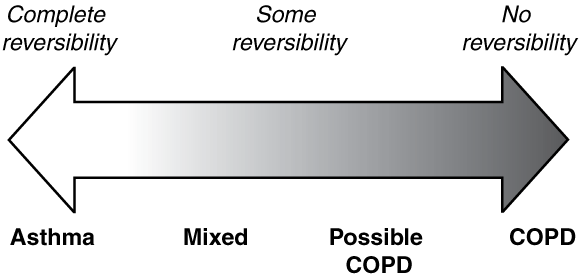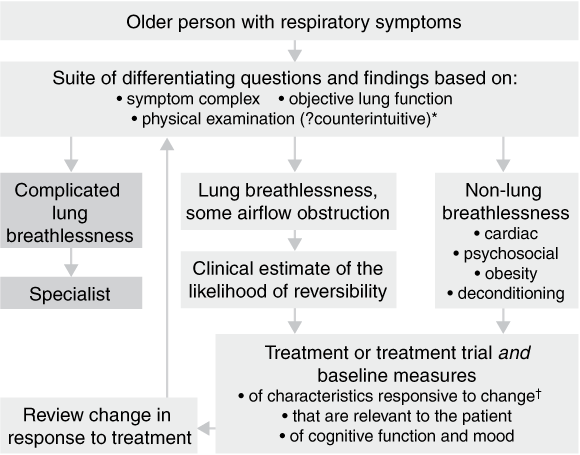Hickam’s Dictum states that “a patient can have as many disorders as he damn well wants to”.1 Older people, who often have comorbidities, encapsulate this adage. To diagnose asthma effectively in older people, we need to know more about how it presents in this population and to understand how to collect efficiently the information that needs to be gleaned from patients or their carers to make that diagnosis.
The American Thoracic Society has described dyspnoea as “a subjective experience of breathing discomfort that consists of qualitatively distinct sensations that vary in intensity”.2 With ageing, there are both mechanical and receptor changes in the lung which alter the perception of breathlessness in older people.3 There is also an aged-related reduction in the perception of dyspnoea with airway constriction.4 It would thus be expected that older people would be less likely to report breathlessness with exertion. However, in studies of the onset of dyspnoea on exertion as a function of physical work and oxygen consumption,2 it appears that dyspnoea comes on sooner in older people, possibly in relation to high levels of ventilation during exercise, or to a diminution in peripheral and respiratory muscle strength. Inconsistent findings like these emphasise the importance of understanding how dyspnoea is perceived and reported in older people. A recently reported cluster analysis of the descriptors of breathlessness2 may be used for a differential diagnosis of asthma, but its relevance to older people is not clear.
Breathlessness, cough and/or wheeze are common symptoms in older people that may be associated with disease in a single or, more likely (according to Hickam’s Dictum), multiple organs. To emphasise the difficulty of diagnosis, it has been reported that, in one cardiac centre, up to 20% of patients with cardiomyopathy were treated with β-agonists before the correct diagnosis was made.5
What we need to know is how to collect efficiently the breadth of history required to cover the common presentations of cough, breathlessness and wheeze, while investigating the symptoms which surround cardiac disease, respiratory disease, deconditioning, obesity, polypharmacy and psychological disorders.
Can self-reporting forms be useful in diagnosing asthma in older people, and is there a role for carers and carers’ reports of breathlessness and asthma symptoms, particularly for older people who are frail and have cognitive impairment?
How should physical examination be targeted? A number of reviews of the diagnosis of asthma in older people have included exhaustive lists of relevant physical examinations.2,5-8 However, the extent of these examinations limits their value in practice. Considering the lack of specificity of breathlessness in older people, it may be more efficient to examine for non-respiratory causes if the presenting symptoms are predominantly respiratory, and vice versa.
Given that reversibility in airflow obstruction has limited value as a marker of treatment response, can improvement in functional measures, such as the 6-minute walk test, be used as a surrogate measure for treatment response?
Many older people have both a reversible and a non-reversible component of their lung disease.7 The importance of each component will vary depending on the mix of lung insults over each patient’s lifetime, and they are only relevant when treating patients at the extreme ends of the spectrum. However, the overlap is important when trying to interpret epidemiological studies derived from symptom questionnaires. We need to know whether, in older people, lung disease with airflow obstruction would be better characterised as a syndrome caused by a spectrum of disease, with asthma at the reversible end and chronic obstructive pulmonary disease at the non-reversible end (see Box 1).
While there are good data on airflow changes with treatment, spirometry reference values for older people only apply to individuals aged 85 years and under,9 and about 15% of older people will not be able to undergo peak expiratory flow rate or spirometric tests.7 In the very old and frail, measures of change in activities of daily living and quality of life are necessary. These measures could be self-rated to improve efficiency.
Peak expiratory flow rates are more difficult to obtain in older people,6 and the flow rates are sometimes too low to measure change accurately. Office spirometry, while not necessarily easier to perform, measures FEV1, which has a better range for measuring change. Spirometry is also essential to confirm obstructive airways disease.10 As this test is operator-dependent, there is a need for a better understanding of how to perform accurate office-based spirometry in older people.
While the statistics surrounding the epidemiology of deaths from asthma as reported in the literature are alarming, what constitutes a death from asthma has been questioned.3 A more detailed analysis of respiratory-related deaths in hospitals would clarify this situation. Without accurate death-rate statistics, improvements in asthma management may not be identified.
Full blood examination, spirometry, chest x-ray, electrocardiography and echocardiography are the more commonly recommended investigations for breathlessness in older people.3,9,11 However, the specificity and sensitivity of these recommended tests have not been tested.
If complex trials of treatment, self-rated functional change and quality of life are to be measured, it is important to know the patient’s underlying cognitive capabilities and mood. Simple screening tests such as the Abbreviated Mental Test Score, Mini-Mental State Examination and Geriatric Depression State are well validated scales.12-14 The Abbreviated Mental Test Score has been correlated with the ability to use metered dose inhalers.15
Tailoring treatment requires the management of polypharmacy, including drugs that complicate asthma management, as well as management of the complexities of asthma treatment. Neuromotor impairment leading to poor hand–lung coordination and hand weakness will influence the choice of inhaler device.16
Asthma is one of the many respiratory and cardiovascular conditions that can limit the activity and mobility of older people. Limited physical reserves and associated frailty are important and reversible characteristics, the management of which can result in significant functional improvement.7
As with most chronic conditions in older people, the breadth of diagnostic assessment required to develop a treatment plan and monitor its outcome is difficult to provide in general practice. Efficient management guidelines (Box 2) and appropriate funding models need to be developed.
- 1. Richardson ML. Radiology of arthritis for the non-radiologist. University of Washington CME Online, 1999. Available at: http://uwcme.org/site/courses/legacy/arthritis/axsutton.php (accessed May 2005).
- 2. Mahler DA, Fierro-Carrion G, Baird JC. Evaluation of dyspnea in the elderly. Clin Geriatr Med 2003; 19: 19-33.
- 3. Braman SS. Asthma in the elderly. Clin Geriatr Med 2003; 19: 57-75.
- 4. Connolly MJ, Crowley JJ, Charan NB, et al. Reduced subjective awareness of bronchoconstriction provoked by methacholine in elderly asthmatic and normal subjects as measured on a simple awareness scale. Thorax 1992; 47: 410-413.
- 5. Kitch BT, Levy DL, Fanta CH. Late onset asthma: epidemiology, diagnosis and treatment. Drugs Aging 2000; 17: 385-397.
- 6. Jack C, Lye M. Asthma in the elderly patient. Gerontology 1996; 42: 61-68.
- 7. Dow L. Epidemiology and therapy of airflow limitation in the elderly. Drugs Aging 1992; 2: 546-559.
- 8. Antic N, Firth P. Diagnosis and management of asthma in the elderly. Med Today 2001; August: 20-27.
- 9. Enright PL, Kronmal RA, Higgins M, et al. Spirometry reference values for women and men 65 to 85 years of age. Cardiovascular Health Study. Am Rev Respir Dis 1993; 147: 125-133.
- 10. Renwick DS, Connolly MJ. Improving outcomes in elderly patients with asthma. Drugs Aging 1999; 14: 1-9.
- 11. Poole PJ. Breathlessness in older people. N Z Med J 1999; 112: 450-453.
- 12. Hoddkinson HM. Evaluation of a mental test score for assessment of mental impairment in the elderly. Age Aging 1972; 1: 233-238.
- 13. Molloy DW, Alemayehu E, Roberts R. Reliability of a standardised Mini Mental State Examination compared with the traditional Mini-Mental State Examination. Am J Psychiatry 1991; 140: 102-105.
- 14. Yesavage JA, Brink TL, Rose TL, et al. Development and validation of a geriatric depression screening scale: a preliminary report. J Psychiatr Res 1982-3;17: 37-49.
- 15. Allen SC, Pryor A. What determines whether an elderly patient can use a metered dose inhaler correctly? Br J Dis Chest 1986; 80: 45-49.
- 16. Armitage MJ, Williams SJ. Inhaler technique in the elderly. Age Aging 1988; 17: 275-287.







Abstract
What we need to know
How is breathlessness perceived and defined in older people?
What impact does breathlessness have on quality of life?
Can history taking and physical examination be tailored to efficiently cover all the organ systems associated with breathlessness?
Can a self- or carer-rated questionnaire be used to identify asthma in patients with breathlessness?
What we need to do
Develop self- and carer-rated questionnaires that measure change in function and quality of life before and after treatment.
Validate objective measures of physical function and airflow that are sufficiently sensitive to measure change with treatment.
Develop a diagnostic guideline in general practice that includes measures of mood and cognitive function and involves carers where necessary.
Provide rehabilitation and restorative care services.